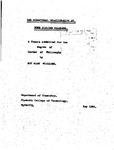THE STRUCTURAL RELATIONSHIPS OF SOME GLYCINE POLYMERS
| dc.contributor.author | WILLIAMS, ROY ALAN | |
| dc.contributor.other | School of Geography, Earth and Environmental Sciences | en_US |
| dc.date.accessioned | 2013-10-09T10:44:51Z | |
| dc.date.available | 2013-10-09T10:44:51Z | |
| dc.date.issued | 1964 | |
| dc.identifier | NOT AVAILABLE | en_US |
| dc.identifier.uri | http://hdl.handle.net/10026.1/2113 | |
| dc.description.abstract |
The Polyglycines are of interest because they are related to nylon and the polyamides, and to the proteins. They resemble nylon in having amine, -NH₂, end groups, and the chains are formed through peptide, C0-NH- linkages. The known Polyglycines are not fibre forming, as products with the required degree of polymerisation have not been prepared, they have a low degree of polymerisation, about 10-20 is the usually recorded value for the number average degree of polymerisation. The degree of polymerisation of the fibre forming polyamides is about 200. The polyglycines may be regarded as the simplest proteins, in that they only contain one amino-acid species, and this is the simplest one. | |
| dc.language.iso | en | en_US |
| dc.publisher | University of Plymouth | en_US |
| dc.title | THE STRUCTURAL RELATIONSHIPS OF SOME GLYCINE POLYMERS | en_US |
| dc.type | Thesis | |
| plymouth.version | Full version | en_US |
| dc.identifier.doi | http://dx.doi.org/10.24382/1602 | |
| dc.identifier.doi | http://dx.doi.org/10.24382/1602 |
Files in this item
This item appears in the following Collection(s)
-
01 Research Theses Main Collection
Research Theses Main


